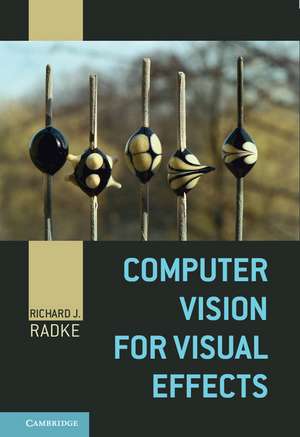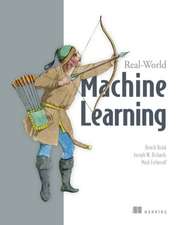Computer Vision for Visual Effects
Autor Richard J. Radkeen Limba Engleză Hardback – 18 noi 2012
Preț: 394.41 lei
Preț vechi: 493.02 lei
-20% Nou
Puncte Express: 592
Preț estimativ în valută:
75.49€ • 82.03$ • 63.46£
75.49€ • 82.03$ • 63.46£
Carte disponibilă
Livrare economică 31 martie-14 aprilie
Preluare comenzi: 021 569.72.76
Specificații
ISBN-13: 9780521766876
ISBN-10: 0521766877
Pagini: 405
Ilustrații: 170 b/w illus. 50 colour illus. 2 tables 168 exercises
Dimensiuni: 180 x 261 x 26 mm
Greutate: 0.98 kg
Ediția:New.
Editura: Cambridge University Press
Colecția Cambridge University Press
Locul publicării:New York, United States
ISBN-10: 0521766877
Pagini: 405
Ilustrații: 170 b/w illus. 50 colour illus. 2 tables 168 exercises
Dimensiuni: 180 x 261 x 26 mm
Greutate: 0.98 kg
Ediția:New.
Editura: Cambridge University Press
Colecția Cambridge University Press
Locul publicării:New York, United States
Cuprins
1. Introduction; 2. Image matting; 3. Image compositing and editing; 4. Features and matching; 5. Dense correspondence and its applications; 6. Matchmoving; 7. Motion capture; 8. Three-dimensional data acquisition; Appendix: optimization algorithms for computer vision.
Recenzii
"Hollywood's achievements in visual effects have been enabled not just by advances in computer graphics, but just as much by techniques from the neighboring field of computer vision. Vision techniques such as camera tracking, 3D reconstruction, and face and body motion capture contribute to most of the visual effects shots we see today. Rich Radke's book Computer Vision for Visual Effects begins with the basics and shows how math, geometry, image processing, and scene understanding comprise these tools that create the movies. Read it and you'll understand an important part of the magic that makes the films we love."
Paul Debevec, Scientific and Engineering Academy Award Winner for Lightstage Work
"Richard Radke has produced a computer vision textbook like no other. The field of computer vision is vast and varied and many techniques apply to only a small number of applications. This book does something completely novel: not only does it provide a clear, current, and detailed examination and explanation of the latest computer vision techniques, it also shows how these techniques are used in the practice of visual effects. Including interviews with visual effects practitioners, this book answers the question, ‘That's a cool technique, but is it useful?’ and it does it in a complete, well-written, and engaging way. Anyone thinking of applying computer vision techniques to visual effects problems (and more) should run to get a copy of this book."
Doug Roble, Digital Domain
"The visual effects industry relies intimately on highly sophisticated computer vision algorithms and also provides one of the primary application areas for such algorithms. Richard Radke's comprehensive textbook on these subjects reviews hundreds of such algorithms with applications to topics such as image matting and compositing, feature tracking and matchmoving, motion capture, and 3D model acquisition. It will surely find a prominent place on both visual effect practitioners' and computer vision researchers' bookshelves."
Richard Szeliski, Microsoft Research
Paul Debevec, Scientific and Engineering Academy Award Winner for Lightstage Work
"Richard Radke has produced a computer vision textbook like no other. The field of computer vision is vast and varied and many techniques apply to only a small number of applications. This book does something completely novel: not only does it provide a clear, current, and detailed examination and explanation of the latest computer vision techniques, it also shows how these techniques are used in the practice of visual effects. Including interviews with visual effects practitioners, this book answers the question, ‘That's a cool technique, but is it useful?’ and it does it in a complete, well-written, and engaging way. Anyone thinking of applying computer vision techniques to visual effects problems (and more) should run to get a copy of this book."
Doug Roble, Digital Domain
"The visual effects industry relies intimately on highly sophisticated computer vision algorithms and also provides one of the primary application areas for such algorithms. Richard Radke's comprehensive textbook on these subjects reviews hundreds of such algorithms with applications to topics such as image matting and compositing, feature tracking and matchmoving, motion capture, and 3D model acquisition. It will surely find a prominent place on both visual effect practitioners' and computer vision researchers' bookshelves."
Richard Szeliski, Microsoft Research
Notă biografică
Descriere
This book explores the fundamental computer vision principles and state-of-the-art algorithms used to create cutting-edge visual effects for movies and television.












